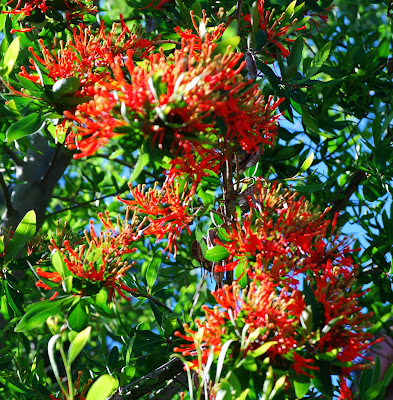Tuesday and Friday, I began teaching a Basic Computer class to eight students with no computer experience at all. Fortunately they were all on the same level, so none of them felt left behind. The going was very slow. We learned to power up and power down the computer, how to minimize and maximize windows, how to copy and paste, and even got email accounts. I had studied the vocabulary for days. My best student is Violeta, 84 years old, who has four computers in her house and doesn't know how to use any of them. She is a delight.
Elder K. and I keep seeing these little hole-in-the-wall shops in which you apparently deposit pantyhose, socks, t-shirts, and other ropa interior, interior clothing. We asked Hna. Rosa and Romy about this, and they laughed and told us these are discount shops for brand new underwear. Whew. We were glad to know.
Every day we pass this house for sale or rent, on the corner of Chacabuco and Colo Colo. Since it is vastly larger than our 400-sq-ft apartment, has a yard with grass and flowers and bushes, and a big courtyard in back with parking, we began dreaming about renting it, at the very least. So far it is still available.
My garden on the balcony. Hermana Rosa kindly gave me a few of her tomates cóctel , cherry tomato plants. I also have ciboletas, chives; my Estrella rose; a spearmint plant, and I planted basil and poppy and calendula seeds. The climate here is very easy on on plants, and so far they are doing well.
Hermana Balden, the mission nurse, wanted me to ask Hna. Rosa about herbal remedies for the young missionaries for insect bites, inflammation and skin problems. Here are some of her unguents, including Calendula for skin; St. John's wort (Hierba de San Juan), Rose Hip ( Rosa Mosqueta) and Calendula for inflammation, and the Eucalyptus and Stinging Nettle for strained muscles.
We finally got an assignment from the bishop of the Universitaria Ward to visit families. We met a set of elders near the University of Concepcion and started walking.
Elder Naranjo from Santiago and Elder McAlister from Utah, walking along the path between banks of poison hemlock. One of the daughters of the family is walking home from school, ahead of us.
The very steep path up to the Verdugo home.
The Verdugos live in the Aguita de la Perdiz neighborhood outside of Concepcion. As far as I can tell, Aguita de la Perdiz means either Gloomy Partridge, Partridge in a Misty Fog, or Partridge Drinking Herbal Tea. (Probably mate, the herbal tea of Chile.) I asked Romy, who says Aguita refers to "little water," in this case a small stream. The homes are not well built. Hna. Verdugo was very sad because her husband had recently left, breaking up their family of six daughters. We promised we would come visit her again.
Containers to keep garbage out of the way of roaming dogs.
Coming down out of the hills, we passed through one of the nicest neighborhoods we have seen so far, outside of the University of Concepcion.
I decided I would try baking cookies. Here I am making brown sugar out of white sugar and chancaca liquida--molasses.
You can also get chancaca in a compressed bar. Break parts off and boil in water to make a brown sugar syrup. Elder K. thinks chancaca bars look like fly bait.
I broke up bars of Sahne-Nuss bitter chocolate with almonds, which made good semi-sweet chocolate chunks. The second batch came out better than the first, since for the first batch the oven had only the top element cooking so the bottom of the cookies were not done. The oven allows you to heat up the top, bottom, or both top and bottom elements for cooking.
Saturday I made a carrot cake using toasted quinoa flour, the nearly flavorless canela (cinnamon--I've tried every variety they have here and it doesn't come close to Costco Saigon Cinnamon), and whole nutmeg, which came with its own little grater. We ate it the Chilean way--with fresh arandanos and frutillas (blueberries and strawberries) from the street vendor, finished with a sauce of vanilla-flavored liquid yogur (yogurt).
At our Thursday weaving workshop--the stylin' Hermana Debora, modeling a rather gorgeous woven bag made by the Institute director's wife.
Hna. Romy modeling a woven skirt.
Another stylin' sister.
Here I am, adding a crocheted edging to sixteen woven squares, which will be sewn together and made into a poncho for Hno. Farias' wife as a thank you for letting him spend time in Concepcion to teach the self-employment seminar.
Hna. Andrea Ramirez, teacher of the weaving workshops, master artist, and the creator of the wall hanging I admired when I first came here. She made a gift of this to me for doing the crochet work for Hna. Farias' poncho.
Hna. Andrea's wall hanging is, as she says, made with cariño y amor, love and affection. It is the Tree of Life, and its roots run deep. The Ramirez family lives on the shores of the Concepcion laguna--small lake--and their property was damaged in the 2010 earthquake. I am hanging this beautiful creation in a place of honor on the wall in our little apartment. Elder K., when he first saw this, thought it was of búhos, owls.







































































